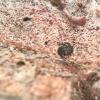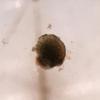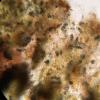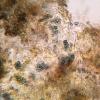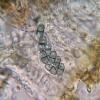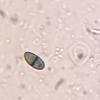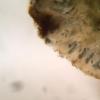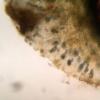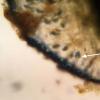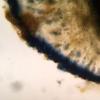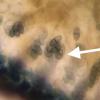
26-12-2025 21:19
Arnold BüschlenPithyella challaudii Pirou. Ist als Bryoparasit in

24-12-2025 17:08
Hulda Caroline HolteHello, I have found this propoloid ascomycete on

21-12-2025 09:32
Hello.A tiny ascomycete found embedded in wood in

21-12-2025 21:32
Pol DebaenstHello, Garden, Burgweg 19, Veurne, BelgiumOn 10/1

22-12-2025 23:38
Patrice TANCHAUDBonsoir, récolte sur un mur en pierre, apothéci
greenish 1-septate spores, saccate asci
Ethan Crenson,
11-06-2019 00:08
Hello all,
I found a few of these tiny black cushions on a branch last weekend in a cemetery in New York. They grew on the same branch as the Orbilia and Barbatosphaeria barbirostris which I posted about earlier. They are smaller than 1mm diameter, sessile, gelatinous in texture. The asci are saccate. The spores 1-septate, greenish in color and measure 16-21 x 8-10µm. In the photos you will see that they appear to be growing in a white subiculum, but I am not certain that it relates to these apothecia. Any ideas?
Thank you in advance.
Ethan
Hans-Otto Baral,
11-06-2019 07:39

Re : greenish 1-septate spores, saccate asci
You need to apply diluted Lugol to see the iodine reaction (possibly lateral wall red, apical wall a thick blue cap, then it is a Dactylospora, now called Sclerococcum.
Ethan Crenson,
11-06-2019 18:46
Re : greenish 1-septate spores, saccate asci
Zotto,
Thank you. When you said diluted Lugol's I didn't realize that it had to be very diluted. My first three mounts were rubbish. This series of images shows the section mounted in extremely dilute Lugol's to which I gradually added a less dilute solution. I think I see the faint reddish tint on the ascus wall (indicated with an arrow). The blue reaction at the apex of the ascus is hard to miss.
Ethan
Ethan Crenson,
11-06-2019 18:47
Hans-Otto Baral,
11-06-2019 20:21

Re : greenish 1-septate spores, saccate asci
Indeed, this is a Lecanoromycete and in all lichens the reaction is very strong. But it is possible by strong squashing to see the details.
Non-lichenicolous species are difficult to identify. Are you sure with the big spore size? Usually spores are smaller.
Non-lichenicolous species are difficult to identify. Are you sure with the big spore size? Usually spores are smaller.
Ethan Crenson,
11-06-2019 22:37
Re : greenish 1-septate spores, saccate asci
In fact I did read the wrong notes when I transcribed the spore size. My apologies. Spores measure: 9-11 x 4-5µm.
